



Last updated : 16th April 2014
As discussed in many areas of this website, until 2014 The Professionals had long been disadvantaged by film prints of inferior quality - particularly noticeable in this age of High Definition television and/or comparisons with other vintage television shows that have benefited from restoration work. In 2012 Contender's fifteen-year license to issue the series on DVD came to an end and they chose not to renew. This allowed Network to take up the challenge of addressing the situation. Contracting out the technical work to the BBC's specialist restoration team, their efforts have spawned newly-created episode prints (first season only so far) that have stunningly transformed the show's visual appearance. What follows is a "layman's version" of Network's own dissertation on the exercise.
Many thanks to Alan and Alys Hayes and Bob Rocca for additional info and advice!
Although releases on video/DVD and television transmissions since the late 1990s have used digital copies of the episodes (which were produced around 1994), these were actually made up from film prints already hampered by picture quality issues. There's a saying in the Information Technology industry: "Garbage In, Garbage Out!". In other words if the source material isn't up to par, you are going to be limited as to what you can do with creating quality new versions. In order to understand why the picture quality suffered and how the BBC has been able to not only turn the situation around but actually make the episodes (first season only so far) look even better than they did on first transmission, we look in detail at the restoration process...
An important aspect of the show's production - and one that has caused some confusion over the years! - is the type of film stock the show was shot on. There were two main formats in use for British television shows. The 35 millimetre type - the measurement refers to the width of the film frame - offered excellent picture quality but was relatively expensive to manufacture and, therefore, buy. So television producers more frequently opted for the lesser 16mm format - cheaper but at the expense of poorer picture quality. This was usually the case with TV shows made in the 1970s, particularly as Britain's economy faltered. (Fans of the 1968 series Department S, shot on 35mm, will have noticed a drop in visual acuity and colour depth on its 1971 follow-up Jason King, shot on 16mm.)...
The partnership of Brian Clemens, Albert Fennell and Laurie Johnson was previously noted for their cinematographic approach to television productions, notable with the use of 35mm stock on The Avengers and, despite 1970s recession, The New Avengers. But the latter series suffered funding problems towards the end of its run due to difficulties with its main financial backers. Also, although London Weekend Television commissioned The Professionals, their own financial input was rather minimal. As such a decision was made to shoot the adventures of CI5 on the cheaper 16mm format...
However the title sequences were shot on 35mm. This is because that footage needed to be duplicated for each and every episode, so it needed to offer the best quality to counteract the inevitable drop that the - downgraded to 16mm - copies would endure.
"Old Dogs..."!
In the era when The Professonals was made, getting the episodes from film camera to television consisted of several stages, each one resulting in the production of a particular type of film "element". Generally speaking, each type of element produces a "colour reverse image" - aka "colour negative" of its source. So initial filming results in a negative image being recorded on the film stock - just like a traditional domestic stills camera. But taking that element and exposing it to another (negative) element results in a positive image - that is, one whose colours match the real world. In other words "negative-to-negative = positive". Overall, then, the result of processing a film "negative" resulted in a "positive" print and vice versa.
The stages, also taking into account the audio aspects, for a particular episode are covered below:
| Visual | Audio | |
|---|---|---|
| Stage 1 Camera Negatives, dialogue and background sounds |
Film the episode! The film cameras use traditional "negative" film stock. To maximise efficiency and minimise cost, scenes are generally shot so that every one involving a particular location are all filmed together. This means that scenes as held on the negative are usually not in the correct order as required for the actual story-telling. (In fact for the series' first season multiple scenes shot consecutively in, for example, Cowley's office were often destined for use in different episodes!) |
Spoken dialogue and background sound (footsteps, gunshots, explosions, vehicles driving by, wind, trees rustling, birdsong, etc) are recorded at this stage, though each of the two aspects on a separate magnetic tape as it may be desirable to subsequently replace the dialogue track for foreign-language sales. |
| Stage 2 "Master Negative" |
(Experienced television scriptwriters develop a knack for how long his/her script needs to be in order to fulfill the timeslot. Occasionally an episode was found to overrun by a few minutes, so some scenes were considerably shortened or dropped altogether. Conversely some episodes from the first season severely underran, so required additional scenes to be written and shot.) A (16mm negative) copy of the opening title sequence is also included at the appropriate point, as are a "textless" version (for reasons discussed later) of the end credits. The addition of these elements now bringing the total runtime to around the usual 50 minutes. The end result of this stage is known as the "Master Negative" for the episode. |
|
| Stage 3 "Intermediate Positive" |
The sample image here shows the picture on the inter-pos to possess a strange orange tinge. We'll return to that shortly... |
|
| Stage 4 Incidental music, sound effects, dialogue re-recording |
The Inter-positive can now be used as a guide for composing and performing of Laurie Johnson's incidental music themes. These are recorded on yet another (separate) magnetic audio reel. Any sound effects that couldn't be created during the filming (eg sound effects of fist-fight punches which, of course, are not enacted for real during filming) are created at this point and added to the background sounds recording made during filming. Due to a mix of primitive technology and the rush to get the episodes completed for transmission, the chaotic first season regularly suffered from poor conditions for recording the actors' dialogue. As such there was much reliance on it being re-recorded at the Harefield Grove studio. This was a tough process for the actors as they had to pronounce words in a way that matched their on-screen lip movements. (There was much less need for dialogue re-recording from the second season onwards as the crew member Dave Crozier developed a superior means for recording audio on location, using a combination of wireless microphones hidden within the actors' clothing and a more "mobile" set-up for the recording machines.) |
|
| Stage 5 Colour Grading, Captions and "Triple-Track" audio |
Back to the Inter-Positive and there is more work required. The orange hue is a special chemical base that allows film technicians to apply "colour grading". This is used to ensure colour tones are consistent across not just the entire episode but also individual scenes. Notable examples would be skintones, clothes, the deep blue of Cowley's later Ford Granada (yes, it's blue, not the black it appears to be in the old film prints!). During filming it's virtually impossible to keep these consistent from one scene to another due to differences in lighting levels, weather conditions and even different rolls of negative film stock. This is particularly true of long and/or complex scenes such as car chases that had to be filmed across different days. At this stage captions are added to present the episode title, the copyright annotation and the names of the director and writer. The credits for the guest actors and film crew used in that particular episode are created on a separate, transparent piece of film stock and subsequently overlaid onto the (textless, as mentioned earlier) copy of the end titles. While being very different beasts, the Inter-pos and Master Neg are hugely valuable for the long-term preservation of the episode - particularly if one of them is subsequently lost or damaged. Of key importance here is that we now have a complete episode consisting of all its visual ingredients. |
Meanwhile the audio elements are brought together on what's known as a "Triple Track reel" (or "Three-Stripe" as it is known in the USA). As its name implies, it is a single reel of magnetic tape that comprises three separate, parallel magenetic tracks. Each one is used to hold the dialogue, incidental music and sound effects/background sounds respectively. This approach not only presents the audio elements in sync with each other and the screen action but keeps them separable, too. It also makes the overall handling of the episode's "package" of visual and audio easier. In terms of standard television transmission, there is another important benefit of the "triple-track" technique: it allows foreign-language markets to easily replace solely the dialogue track with their own spoken language (dubbed by other actors) if they prefer that to using on-screen dialogue sub-titling. Importantly, a duplicate Triple-Track is also produced at this stage, for reasons which will become clear below. |
| *** At this stage we now have all the visual and audio elements produced for the episode. *** | ||
| Stage 6 "Intermediate Negative" |
Also note the white-coloured border around the image. When the Inter-Negs were made, they didn't wholly capture the entire picture area of the original frame. This is because the 16mm film format - which had been an industry standard since the early 1930s - that was used to shoot the episodes doesn't quite match the traditional 4:3 width:height ratio of television screens. |
|
| Stage 7 Transmission prints and audio |
Indeed the example here reflects the muted colours and lack of detail and sharpness that the old prints suffer, having been produced from Inter-Negs that were already heavily worn. At this point the Inter-Neg would normally have been junked and a new one created from the Inter-Positive, as per Stage 6. Unfortunately London Weekend Television chose to keep using the existing Inter-Negs.
(Alternatively a broadcaster would not request any interstitials but carry out the insertions themselves - possibly using different imagery and/or music - after they had taken delivery of the Transmission Prints.) The original interstitial - with the "typewriter" font - appears as an extra on Network's first season DVD and Blu-Ray box-sets. |
When it came to the audio aspects for Transmission Prints, the broadcaster could simply request that the duplicate Triple-Track (created in Stage 5) is used to create a "mixed-down" monophonic (stereo television for the UK didn't start until the 1990s) magnetic reel where all three audio elements are combined (and thus subsequently inseparable) onto a single track... Alternatively the Triple-Track duplicate could actually be dubbed straight onto the Transmission Print itself, if it is of a type known as a "Combined Print" or "Optical Sound Print". These possess a narrow, monophonic, magnetic audio track running parallel to the film frames. The advantage of this approach is that there is less physical material for the broadcaster to handle and store. The disadvantage of this media from the audience's perspective is that it offers poorer sound quality than the separate-reel option. As with the Inter-Neg, the Triple Track duplicate is likely to be used many times and therefore wear out. At that point the original Triple Track can be used to make a new duplicate. Alternatively, to maximise sound quality, a new Triple-Track duplicate can be created from the original, physically separate recording reels. (However in reality this would be unlikely to happen as it would be very costly.) |
Stage 8 – Digital days: the "D2" tape
From the late 1980s a further stage was could be undertaken. A Transmission Print and Audio created in stage 7 could be used to create a copy of the episode on the then-new industry-standard digital "D2" tape. Housed in relatively small "cassettes", these were more portable and took up far less storage space than traditional film print canisters. The Professionals had D2 versions of all its episodes created around 1994 and it was these that, until Network and the BBC undertook the restoration project, were used for television repeats and VHS/DVD releases. But by that time the Transmission Prints to make the D2's were in poor shape and thus so were the digital copies... which is where we came in!...
That covers the original process to prepare the episodes for transmission. However the restoration work done by Network and the BBC confirmed an oddity that Ros Connors, who kindly provided technical information for the Episode Guide, suspected. Although we know that the second, "Car-Through-Glass", title sequence was "retro-fitted" to the first season's episodes, this work was carried out by London Weekend Television on those episodes' Master Negatives. This is most unusual in the television and movie industry - indeed some would view it as irresponsible to not only tamper with original source material but one that is so physically vulnerable. Either way it seems to show that somebody at London Weekend Television was determined that the montage of CI5 battling its way through the warehouse was never to be seen again!! Indeed it's a small miracle that the "Assault Course" footage was not junked...
As we shall see, this and subsequent further meddling contributed to a detrimental effect on the Master Negatives which, in 2013, was to give the BBC Restoration Team some major problems...
"Discovered in a Basement"!
Into the 21st Century and we now have High Definition television. This made it increasingly obvious that the existing digital ("D2") tapes that had been used for broadcast repeats since the 1990s and as a source for VHS & DVD releases had significant shortcomings in picture quality, particularly alongside other vintage shows which had benefited from new prints being created for them. From the outset, Network made it clear that without the opportunity to apply the same treatment to The Professionals, they had no interest in issuing the series. And that meant reverting back to the Master Negatives because, in theory, they would not only provide the best possible picture quality but one that could truly be used to meet the standards of High Definition. The Inter-Positives would probably be an acceptable second option...
But there was a problem - one which many fans of the show were well aware of: seemingly nobody at LWT (actually rival ITV regional broadcaster Granada now) knew where these elements were. Happily enquiries soon uncovered the truth: the Master Negatives, Inter-Negatives, Triple-Tracks audio reels (plus a handful of original audio elements) and other valuable material had been shipped to the renowned British Film Institute some time in the mid-1990s to be stored in their vault. (The Inter-Postives, however, remain unaccounted for). Why nobody readily knew this until Network instigated enquiries is a mystery, although as the transferral of the materials took place around the time LWT was taken over by Granada, it's possible that there had been a communications breakdown and/or staff redundancies led to the loss of vital knowledge.
"A Stirring of Dust"
With the Master Negatives now rediscovered, Network and the BBC were able to commence their ambitious joint programme of creating fresh, clean High Definition prints of the episodes. However it wasn't plain sailing. Although film negatives do decay even when stored in air-tight containers (as they should be), nobody was quite prepared for just how much damage and deterioration these elements had suffered over the decades when the canisters were opened in 2013. As well as general scratches and scuffs acquired through poor manual handling, the Restoration Team had the following additional issues to battle against:
1 - Significant wear and tear to the sprocket holes.
These are the small rectangular holes either side of each film frame used to feed the negative into various machines for processing. The wear to the holes suggests that the negs had been spooled up by LWT technicians many times for some reason – absolutely against received wisdom! This type of damage means that the negative will not be fed "cleanly" and the picture would appear to "wander" left and right as it is played, along with other stability issues. Some sprocket holes were torn through - or close to it - which detracted further from the already delicate physical integrity of the negatives.
2 – Splicing tape
On some episodes the scene-to-scene joins were found to be supported by splicing tape, seemingly laid down by LWT technicians to compensate for the aged adhesive that had been used in 1977. Unfortunately the tape caused discoloration to the film frames underneath it and inattentive application had led to dirt and dust being trapped and scratching the film.
3 – Chemical decomposition
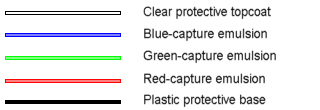 Colour film stock comprises three main constituents, photo-sensitive gelatin-based layers known as the "emulsions" – each to capture the red, green and blue attributes of the picture respectively... although as this is a colour negative, they appear on the film stock as cyan, magenta and yellow. It is the separation of these primary colours which makes it easy to apply the aforementioned "colour grading".
Colour film stock comprises three main constituents, photo-sensitive gelatin-based layers known as the "emulsions" – each to capture the red, green and blue attributes of the picture respectively... although as this is a colour negative, they appear on the film stock as cyan, magenta and yellow. It is the separation of these primary colours which makes it easy to apply the aforementioned "colour grading".
Additionally two further layers are added: a top, transparent layer and a bottom "base". These provide a limited degree of protection against scratching of the emulsions and contribute to physical integrity.
The emulsion layers on many of the first season episodes were found to be peeling away or congealing in particular spots. (More on this later.) The Professionals was shot on film stock manufactured by Kodak-Eastmancolor. As popular as this was at the time, it has subsequently been found to suffer from high levels of decay in comparison to that of rivals such as Agfa and Fuji. The BBC's Jonathan Wood, working on the Restoration Team, had previously performed a similar exercise on The Sweeney – a slightly older series - and commented in an interview that the negatives for that show were in far better shape.
"... New Tricks"!
With these challenges to overcome, the general process for producing the new High Definition prints for each episode was as follows:
| Stage 1 Restoration: Master Negative repair |
With the problems indicated earlier, it was vital to minimise any possibility of further damage occurring when the Master Negative was processed by the BBC. Each scene-to-scene join was checked and, where necessary, repaired. Normally the aforementioned sprocket hole problems would need addressing, too, but fortunately the latest technology - covered below - removes the need for this extremely laborious task! |
|---|---|
| Stage 2 Restoration: Master Negative cleansing |
A chemical process was used to carefully clean off as much dust, dirt and grease as possible from the negative's top clear plastic layer. The process was then followed up with ultrasonic cleaning. This is ingenious in that it sets up sound wave vibrations that cause any remaining surface contaminants to be literally shaken loose without risk of further damage to the film stock. |
| Stage 3 Opening Titles, closing credit seqences and captions |
As discussed earlier, the Master Negatives for all the first season episodes had had the later "Car-Through-Glass" opening and "silhouettes" closing credits sequences grafted onto them. Network was keen to present the episodes with visuals as close as possible to their original 1977/78 transmissions and therefore looked to revive the "Assault Course" and "London cityscape" versions. Luckily the negatives for both of these had survived - the latter being usefully "textless"... Captions that were unique to each episode - ie Episode Name, Writer, Director and the closing credits for guest actors and crew - all existed as text-only "transparent" film reels and were included in the repair and cleansing processes detailed above, to be handled later. |
| Stage 4 Remastering: Produce a digital "positive" |
Although traditional production methods would demand creation of an Intermediate Postive and, subsequently, an Intermediate Negative in order to produce saleable prints, modern technology allows us to short-cut the process. The Master Negative, now repaired as much as safely possible, is carefully spooled up in a "Scanity" unit (manufactured by the Digital Film Technology company) to produce a digital positive "print" onto a computer Hard Disc. The Scanity incorporates a scanner which is capable of taking a High Definition image of each frame on the negative in turn (at around 25 frames per second, which means each fifty-minute episode can be scanned in "real time"). Another advantage of the Scanity is that it doesn't rely on the negative's sprocket holes, which was fortunate for this exercise as so many of them were damaged. The title sequence and (textless) closing sequence were also inserted at the appropriate points, along with overlaying the aforementioned caption elements appropriate to the particular episode. At this point, then, we have all the required visual elements assembled to reconstruct the episode. |
| Stage 5 Restoration: Digital clean-up and repair |
The majority of these were handled by software tools, mostly via automated scan-and-repair processes. However the more major ones usually required manual intervention with the software. The example here is taken from 'Long Shot': "Library" footage such as the Middle Eastern city which opens 'Long Shot' or the crowd riot scenes in 'Look After Annie' presented additional challenges. Although they were, of course, included as part of the High Definition scanning process, they were usually of inferior visual quality in the first place – and the Hi-Def treatment only highlighted the differences between them and the normal episode footage even further. Thus the BBC team applied extra effort to digitally enhance such scenes so that they more closely conformed with surrounding footage. Great care was needed here because too much enhancement would have rendered the picture rather "artificial"-looking. It's always a question of balance between quality and looking natural. |
| Stage 6 Restoration: Colour grading |
As discussed earlier, in traditional film preparation, the colour grading stage is carried out on the Inter-Positives. However because the new prints had been created from the Master Negatives, this meant that the colour grading had to be done again. A combination of human judgement and automated software process was used on the digital print to apply a consistent set of colours/shades across the episode. (Actually, even if the Restoration Team had been able to use the (still-missing) Inter-Positives, they would likely have elected to carry out fresh colour grading anyway as modern digital techniques allow it to be achieved to a far higher standard than in the 1970s.) |
| Stage 7 Audio restoration |
It wasn't just the picture that Network and the BBC felt needed to be rejuvenated! Thankfully amongst the haul found at the British Film Institute, the aforementioned "Triple-Track" tapes had survived for all first season episodes. As discussed earlier, this medium provides the best of both worlds: all three elements synchronised together to provide the complete audio for the episode that can be played in tandem with the film print – but also the easy possibility to extract them individually. This is why it has been possible to accompany each episode with an "Isolated Music" option on the new DVDs and BluRays. Digital copies were made of the individual audio elements and then software tools were used to clean them up and carefully enhance them, for example removing the "hiss" that traditionally accompanies old analogue tape recordings. The most obvious improvement over the old prints is the bass part of the sound spectrum, particularly in background sounds: for example when Charley Turkel climbs into the Mercedes in 'Old Dog with New Tricks', the door slams with mighty "thunk"! |
A final word on the audio aspects. We had come to expect that on original UK transmission of the first season, the opening titles were not only the "Assault Course" version but the title theme was the earlier mix which (inseparably) included Cowley's "Anarchy, acts of terror, crimes against the public..." narration. By an amazing stroke of good fortune, the material at the BFI included copies of the very prints used for the original 1977/78 transmissions. These showed that, in fact, the only episodes to use the "Anarchy" version of the theme was 'Private Madness, Public Danger', 'The Female Factor' and 'Long Shot'. Somewhat surprisingly the series' intended opener, 'Old Dog with New Tricks' did not. This and the remainder used the more common version of the theme.
That covers the main activities of the remastering and restoration process. However one particular episode could not be entirely recovered in this way...
"When the Emulsion Comes Off"!
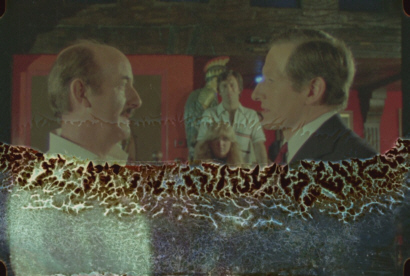 So far there has only been one episode whose Master Negative presented insurmountable problems. The opening thirteen minutes of 'When the Heat Cools Off' was found to be in an irretrievable state of decay, with the colour emulsions having congealed into a sticky gloop! The image shown here is a "positve conversion" of one of the affected film frames...
So far there has only been one episode whose Master Negative presented insurmountable problems. The opening thirteen minutes of 'When the Heat Cools Off' was found to be in an irretrievable state of decay, with the colour emulsions having congealed into a sticky gloop! The image shown here is a "positve conversion" of one of the affected film frames...
With the Inter-positives still missing, the only option was to resort to the episode's Inter-Negative and fortunately this turned out to be usable. As discussed earlier, however, this presents a slight drop in picture quality. Nevertheless the BBC team has applied further digital enhancement techniques and brought the visuals for this episode up to a very high standard. However because the Inter-Negs never captured the extreme edges of the frame from their parent Inter-Positives, the picture area of the affected scenes is similarly "fore-shortened" in the new version.
"Heroes"!
Although the Master Negatives for Season 1 are in a poor state, modern technology, vast experience - and a lot of luck in terms of the materials that have survived - allowed the BBC team to not only overcome all of the difficulties - with far more effort and dedication than was originally anticipated – but produce astonishing-looking new prints! As such the team deserves very high praise.
As the BBC and Network continue their restoration programme on the series, this page will be updated.
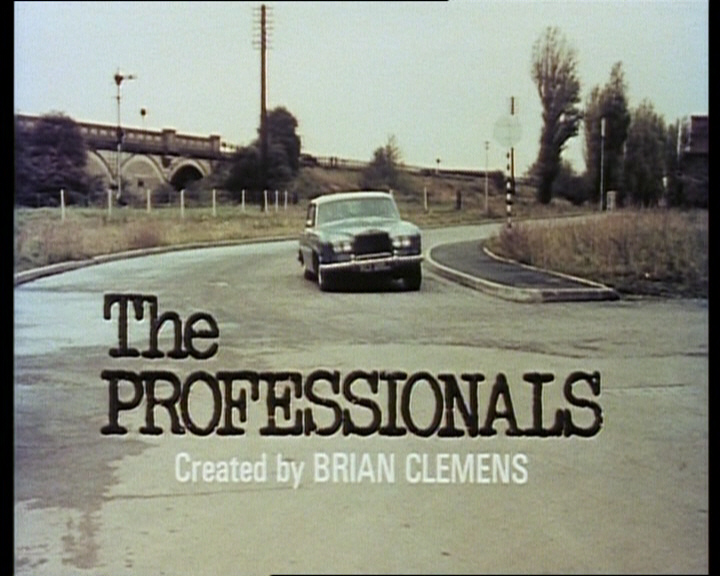
|
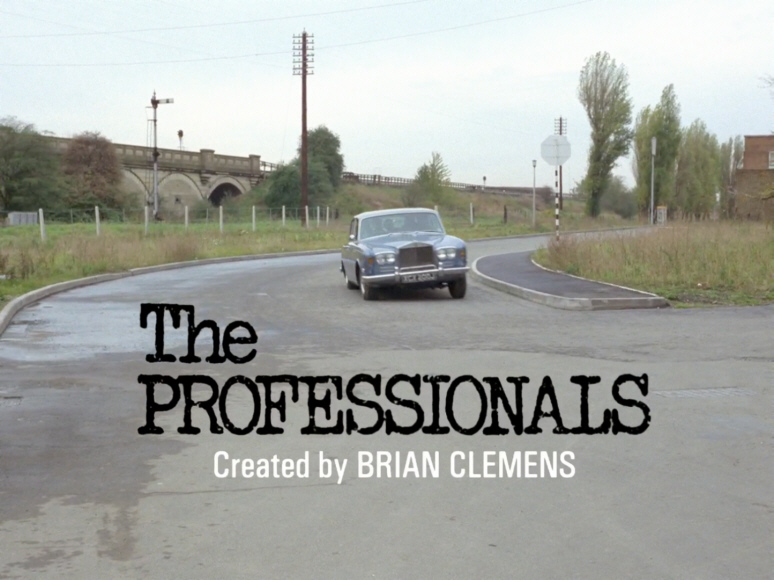
|
The BBC Digital Media Services Team comprises Daniel Comben, Sheona Henderson, Amanda Whitby, Harvey Williams and Jonathan Wood.

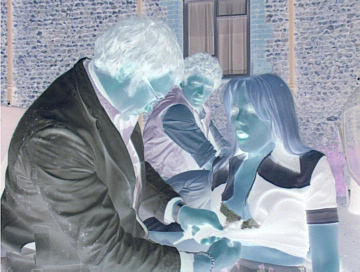 Once all scenes for the episode have been shot, the recorded negative film stock from the cameras is cut into individual scenes as per the script and then reassembled into the correct story-telling order. Naturally a lot of the footage will be waste due to scenes having to be re-shot but also "good" scenes may need trimming a little to ensure the episode runs to around 49 minutes. The separate strips of negative that are to be included in the finished product are physically joined together using an adhesive.
Once all scenes for the episode have been shot, the recorded negative film stock from the cameras is cut into individual scenes as per the script and then reassembled into the correct story-telling order. Naturally a lot of the footage will be waste due to scenes having to be re-shot but also "good" scenes may need trimming a little to ensure the episode runs to around 49 minutes. The separate strips of negative that are to be included in the finished product are physically joined together using an adhesive.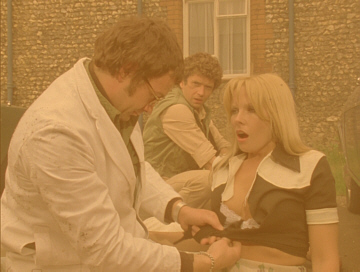 Because the Master Negative is physically delicate, given that it relies on adhesive to hold it together, its use should be kept to an absolute minimum (though, as we shall see, this didn't happen with The Professionals!). It is carefully handled in order to produce what's known as an "Intermediate Positive" (or "inter-pos"). Because the Master Negative is now assembled in the correct scene order, the inter-pos is a continual, single stream of film stock that doesn't use joins.
Because the Master Negative is physically delicate, given that it relies on adhesive to hold it together, its use should be kept to an absolute minimum (though, as we shall see, this didn't happen with The Professionals!). It is carefully handled in order to produce what's known as an "Intermediate Positive" (or "inter-pos"). Because the Master Negative is now assembled in the correct scene order, the inter-pos is a continual, single stream of film stock that doesn't use joins.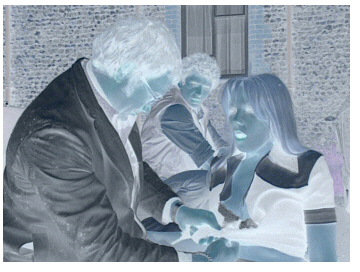 The Inter-Pos is NOT used to create film prints for transmission. The reason for this is that such a valuable resource would become quickly worn out, particularly bearing in mind that for a show such as The Professionals, many transmission film prints were required when the show started selling overseas. Instead it is used to produce an "Intermediate Negative" – "Inter-Neg". (Remembering the "Negative -> Positive -> Negative -> Positive" chain of production.) The downside to this approach is that we are now two "generations" down from the original Master Negative, thus picture quality is starting to reduce (though, of course that's difficult to tell from a negative!).
The Inter-Pos is NOT used to create film prints for transmission. The reason for this is that such a valuable resource would become quickly worn out, particularly bearing in mind that for a show such as The Professionals, many transmission film prints were required when the show started selling overseas. Instead it is used to produce an "Intermediate Negative" – "Inter-Neg". (Remembering the "Negative -> Positive -> Negative -> Positive" chain of production.) The downside to this approach is that we are now two "generations" down from the original Master Negative, thus picture quality is starting to reduce (though, of course that's difficult to tell from a negative!).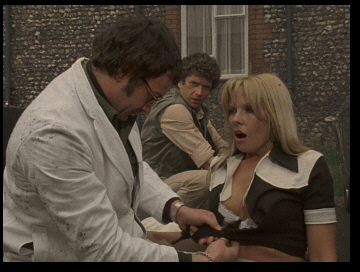 The Inter-Neg is used to create as many (positive) film prints for television transmission (at last!) and video release (and, between 2004 and 2012, DVD) as desired. The Inter-neg can be used in this way dozens of times but, of course, gradually wears out to a point where the resultant quality of the positive prints becomes unacceptable...
The Inter-Neg is used to create as many (positive) film prints for television transmission (at last!) and video release (and, between 2004 and 2012, DVD) as desired. The Inter-neg can be used in this way dozens of times but, of course, gradually wears out to a point where the resultant quality of the positive prints becomes unacceptable...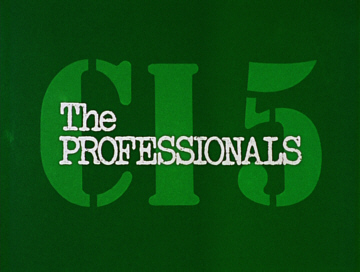 Another aspect to be considered here is that of breaks for adverts, which were usually bookended by the short drum roll and brass fanfare that is heard right at the end of the main theme, accompanied by a shot of the 'CI5' logo. These little clips are often referred to as "Interstitials". Although original transmission for the UK had two breaks per episode, overseas broadcasters - and, much later, UK satellite screenings - often required more. So the Transmission Print would have these inserted as per the broadcaster's requirements.
Another aspect to be considered here is that of breaks for adverts, which were usually bookended by the short drum roll and brass fanfare that is heard right at the end of the main theme, accompanied by a shot of the 'CI5' logo. These little clips are often referred to as "Interstitials". Although original transmission for the UK had two breaks per episode, overseas broadcasters - and, much later, UK satellite screenings - often required more. So the Transmission Print would have these inserted as per the broadcaster's requirements. Photographic and other flaws in the Master Negative that could not be eradicated as part of the cleansing process would, of course, have been carried over to the digital print. The most common problems were:
Photographic and other flaws in the Master Negative that could not be eradicated as part of the cleansing process would, of course, have been carried over to the digital print. The most common problems were: